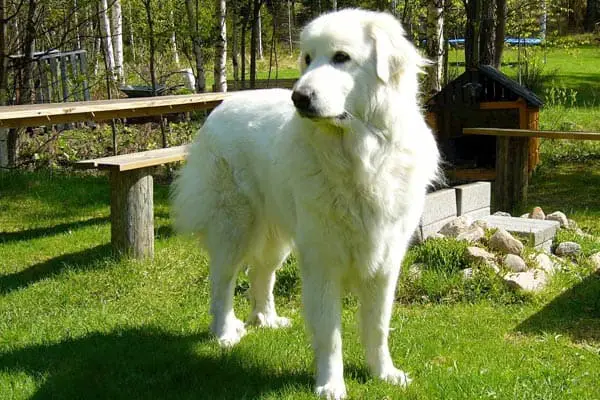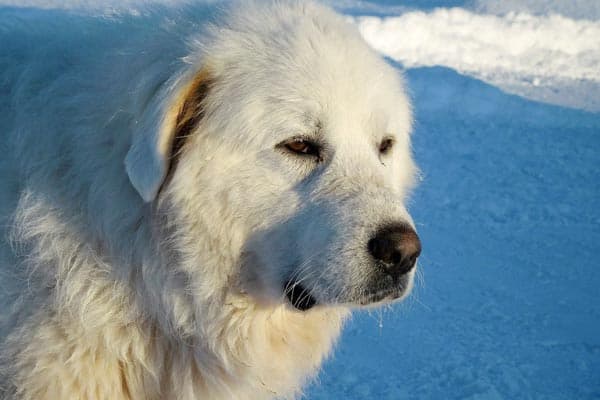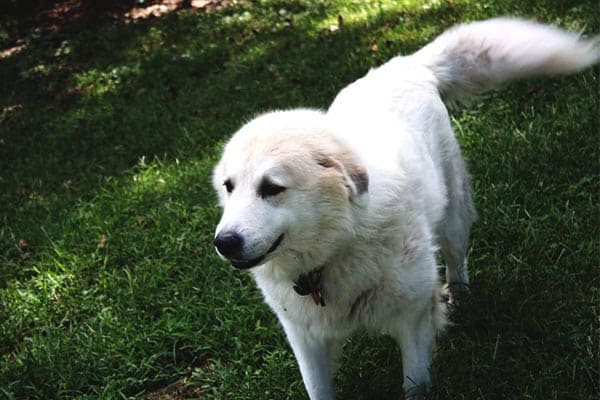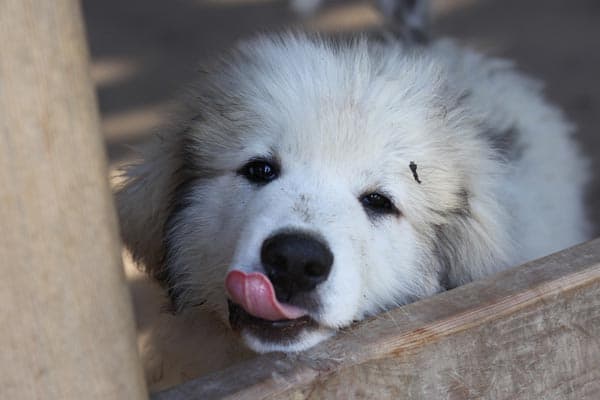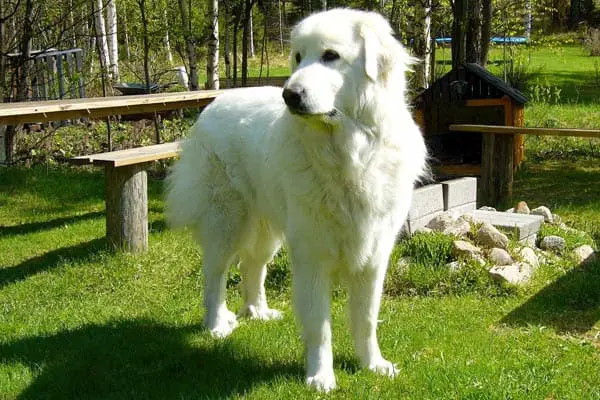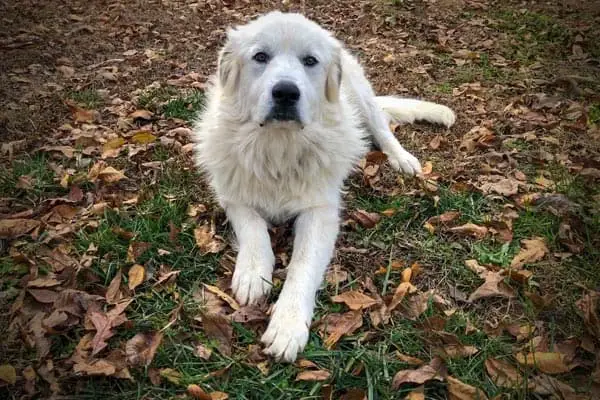Great Pyrenees Behavior Problems: How to Look at and Solve
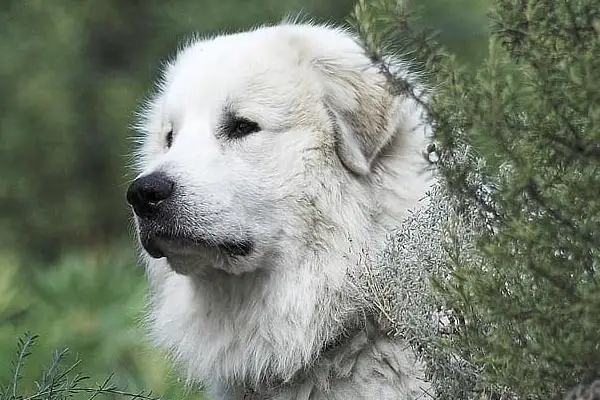
Topics on behavior problems in dogs are always hot ones. An owner is most likely to surrender his or her dog because of a behavioral challenge. Unwanted behaviors run the gamut from house soiling to destructive chewing to biting people.
It is only natural that you would want to know if behavior problems are breed-specific.
Some problems encompass all types of dogs, including mixed breeds, while others are more prevalent in groups of dogs such as those in the herding class. Our focus in this article is on the Great Pyrenees, a livestock guardian dog of the working group.
Most of the serious Great Pyrenees behavior problems originate from their original working purpose.
The breed’s characteristics of protectiveness, suspiciousness of strangers and unfamiliar animals, wanderlust, and courage can lead to problems such as aggression towards people and other dogs as well as unfortunate encounters with vehicles and firearms. Other behavioral issues stem from training difficulties exacerbated by the breed’s independence.
Finally, you can see typical unwanted behaviors of large breed puppies such as nipping, jumping on people, and roughhousing.
What are the training challenges of the Great Pyrenees?
When you look at the Great Pyrenees, what probably strikes you first is their impressive size. Right away you would recognize that a giant-sized dog is not going to be one you can force to do anything.
The keys to success are starting your dog’s training at a very young age and learning methods to communicate with your pet that does not involve physically overpowering her.
Another often overlooked barrier is the Great Pyrenees’ intelligence. While many owners assume a smart dog is easy to train, the opposite is frequently the case. Pyrs can think for themselves and their use as LGDs requires it.
Yet another challenge is that even if you start with a puppy as you should, the Great Pyrenees does not mature physically for 18 to 30 months. Moreover, it can be two or three years before all your training begins to click on a mental level.
You will face fewer difficulties if you recognize basic training challenges specific to the Great Pyrenees and formulate a game plan to tackle them. Proceed with patience and repetition and avoid rushing any step of training.
- A male Great Pyrenees can reach 160 pounds, and Great Pyrs are tall dogs with a shoulder height of 26 to 32 inches. You need effective tools like the proper leash and collar equipment.
- Independent thinkers – unwillingness to follow commands can be seen as obstinate or disobedient; it is important to use persistence rather than force
- Sensitive dogs – force is ineffectual both physically and mentally; Perseverance and positive reinforcement are key
- Late maturation – as large dogs, Pyrs mature late physically, but their mental development is also longer than many other breeds; set expectations accordingly
- Protective – need early socialization
- Bond with animals in their care – if your Great Pyrenees works in the field, the challenge is to encourage their bond with livestock but also get them to accept people
Is biting an issue with the Great Pyrenees?
A well-trained Great Pyrenees is not a biter. However, when training the breed, you will stumble across normal puppy biting behaviors. You will also experience biting behaviors unique to the Great Pyrenees that may pose problems.
Sometimes a challenge arises when the dog is carrying out his job, but on other occasions, it can stem from poor socialization or ineffective training.
How to Control Puppy Nipping
The Great Pyrenees is not immune to growing pains. It is not a herding breed so nipping as a puppy does not tend to be worse than it is in some of the guarding breeds like the Rottweiler. However, it can easily develop into a persistent behavioral problem if you do not discourage it at the onset.
Since Pyrs are large pups, it is common to start engaging in roughhousing and playing with their mouths. When small, their teeth may not hurt, but as your pup grows, the biting behavior becomes less cute and more ingrained.
By the time your dog is a year old, biting can escalate into physical injury. Your commands will fall on deaf ears because your dog is conditioned that rough biting is part of normal play.
Keep in mind, if you for some reason acquire a puppy before the age of nine or ten weeks, your challenge of stopping puppy nipping might be even more difficult. Puppies continue to learn proper social behaviors from their littermates even after weaning.
Some Great Pyrenees pups become orphaned while others are the products of breeders who are anxious to get them out of the house.
There are a couple of approaches to curtailing early puppy biting. Any training method you choose requires a clear and consistent command such as, “No” or “Stop” when your puppy bites. You should deliver it as quickly as you can right before the bite or during the act.
Prevention
Prevention has limited success in training a pup not to nip because most instances are not predictable.
You can, however, make a note of whether biting increases right before feeding or bedtime, after a nap, or during certain games when you are playing.
You can get ready with one of your methods at the outset of one of the triggering activities. Otherwise, prevention entails avoiding play at times when your puppy is most apt to bite.
Redirect
One of the most effective methods to train against any unwanted behavior is to redirect your puppy’s attention. Redirection works even better if you can establish a favorite toy or activity.
When your pup starts nipping you, try to refocus her attention on a toy or perhaps a training activity. You can arm yourself with treats and give simple commands amid your puppy biting or when you sense her play is getting too intense.
If redirection does not work in a particular instance, end your play session. As your puppy gets older, other distraction tools than toys may prove effective.
- Take your dog for a walk
- Offer a treat
- Train a fun trick your dog is good at
Ignore
The advantage of ignoring your puppy’s bad behavior is that it can be effective even if your pet is not very playful.
However, it assumes that your pup is bonded to you enough that she will be bothered by your withdrawal of attention. Also, it can frustrate your puppy. Extreme frustration is counterproductive to learning and receptivity.
Ignoring your dog is a difficult skill to learn to implement effectively and consistently. When your pup first begins biting, stop playing immediately. Stand up and turn your back or walk away and do something else.
Ignore your puppy until he modifies his behavior. It may take a few seconds or a couple of minutes. Wait for him to look at you or sit down. Do not reward pawing, crying, or nipping your leg for attention by turning to your puppy.
He should be calm and respectful, and then you can resume play or move to another form of attention.
Sprays
We do not advocate spraying anything in your puppy’s face to deter biting. Spraying water or air in your dog’s face will likely backfire on you and hurt your bond with her. At the least, it will escalate your pup’s behavior if she thinks it’s a new game.
However, you can spray substances like Bitter Apple on your hands and arms. Such sprays discourage biting because they taste noxious and sometimes produce an uncomfortable sensation. Make sure to always use products formulated for dogs with proven animal safety.
Some puppies will not respond to unpleasant tastes, and you will not notice any deviation in their biting behaviors.
How do you prevent Great Pyrenees Aggression?
If you neglect socializing your Great Pyr, he could become either aggressive or timid. Both types of dogs may bite indiscriminately. A fearful dog can even turn on you under extreme circumstances.
Exposing your puppy to various environmental situations, people, and animals is crucial to his emotional and mental development. By taking him to numerous places and introducing him to strangers, you can teach your dog how to differentiate danger from everyday occurrences.
A protective dog without the skill of discernment may bite one of your guests. A less confident dog will cower or try to slink away at the first sign of anything suspicious.
A well-trained properly socialized the Great Pyrenees is calm, confident, and courageous and relies on intimidation rather than biting to relay his message. Viciousness and shyness are uncommon but severe Great Pyrenees behavior problems.
Livestock guardianship is not a behavior problem
The Great Pyrenees was bred for generations to be ferociously protective of its flock. Whether from a misplaced act of good intention or a nefarious agenda like theft, some people make the mistake of approaching the Great Pyrenees on duty.
Such a dog may threaten to bite an intruder, but this action is not a behavior problem. Just like a guard dog, an LGD may attack others while executing the requirements of his job.
The Great Pyrenees is a barker
Barking is part of the Great Pyrenees’ adaptations to its livestock guardian duties.
While guard dogs bark to ward off would-be burglars and others, Great Pyrenees sound off loudly to message predators.
They alert wolves and bears of their presence with a flock and warn those that venture too close to scram. The Great Pyrenees will back up its bark with pursuit if the predator’s response is not quick enough.
The problem with the Great Pyrenees’ bark in a family setting is that is exceedingly loud and frequent. Moreover, the breed tends to be nocturnal, so a lot of barking occurs through the night.
You are unlikely to eliminate barking in your dog, but you can try to decrease its frequency. Socialization is one of the most effective tools you can use to prevent incessant barking.
Take your dog everywhere and expose her to a variety of stimuli so she does not look at so many sights and sounds as threats.
Another weapon against excessive barking is exercise and mental enrichment. The Great Pyrenees do not need huge amounts of physical activities, but their fair share of exercise will help resolve many behavioral problems including barking.
If your Pyr is a household pet, try to keep her indoors overnight. Try is the operative word as this can be challenging if your home is warm.
Moreover, the Great Pyrenees has the drive to explore its outdoor environment. You can also try to increase your dog’s daily activities in hopes she will want to rest at least some of the night.
Finally, prevent boredom through mental engagement and problem-solving activities. Eliminate boredom as a potential cause of excessive barking.
If your dog does not work, you must avoid leaving her alone for extended periods. Some dogs in this situation will chew or dig, but the Great Pyrenees will tend to bark and try to escape.
When your dog does bark, investigate and acknowledge her efforts. Do not scold a barking dog.
Note the loudness and persistence of the Great Pyrenees’ bark. Three dogs join in the effort, but the video focuses on one.
You can see that if these dogs were outside at night it might pose an annoying problem.
The video does not go long enough to tell for certain, but it appears the dog relaxes at the end when the owner acknowledges it with a, “What’s wrong?”
Great Pyrs have wanderlust
The Great Pyrenees has a strong tendency to wander off. Even when performing their livestock guardian duties, it is normal for the Great Pyrenees to roam their territories at length.
Pets seek to get out of the yard and can face danger mainly from traffic and from the liability that comes of allowing your huge dog to run loose.
You should take multiple approaches to your dog’s tendency to roam and skills as an escape artist.
Physical Barriers – Fencing
Physical barriers typically should be rather extreme for the Great Pyrenees. It is well worth it when you consider that in the country it might be legal for a rancher or farmer to shoot and kill your dog.
Invisible fencing is not a recommendation for the breed. The prongs of an electric collar cannot reach your dog’s skin unless you clip the dense ruff of fur around her neck.
Moreover, it allows unwitting animals and children to wander into your yard, setting them up for a defensive attack.
Chain-link fencing can work but you usually need to reinforce it with electricity or additional sturdy materials.
If you do not use electric means to get your dog to respect the barrier, you must reinforce it at the bottom and top. Buried chicken wire around the fence perimeter can keep your dog from digging underneath the fence. Other types of panels may not require burial to be effective.
Chain-link fences also need protection from pressure if your dog tries to push it outward. Hog panels, tension wires, or cables work against this problem.
Coyote rollers are effective at preventing your dog from climbing over the fence, although you still need a high barrier. Some owners use hog panels and other means to create a barrier to clearing the fence.
They also prevent animals from jumping into your yard. Make sure any innovative techniques you employ are not hazardous to your dog.
Additionally, you can use climb resistance fencing. Six or seven feet is how high your fence should be for your Great Pyrenees.
Gate latches are as important as the type of fence you select. You must consider several properties when choosing latches to enclose a Great Pyrenees.
- Tamper-resistant – your dog will test them
- Consider installing latch gates higher than standard to make them less convenient for your dog
- Automatic self-latches
- Fork latches – require extra security such as using a bungee cord
- Heavy-duty latches with the ability to padlock
Training
Specialized training can be an excellent way to get your dog to respect the fence around your property.
Your priority should be to make sure your dog responds promptly when you call her name or tell her to come to you.
Then you can use a few methods to teach her to respect the fence, whether to not touch it or merely not to climb onto it.
Training methods aim for short gains over the long term. You may never be able to completely trust some individuals to respect the fence when you are not around.
- Ribbons
- Tape
- Ropes
Each method involves you setting up boundaries with the prescribed materials and rewarding your dog for turning away from the barriers. Always enlist a professional trainer’s help or consult if you struggle with any of the steps to reaching your goals.
Stop your Great Pyrenees from jumping on people
Most dogs like to greet people by jumping on them. Once a large breed dog matures, her jumping behavior can be intimidating and dangerous. Knocking your guests to the ground is not the kind of greeting you aim for.
Dogs jump on you and your guests in their enthusiasm and because it invariably gains attention, even if it is negative. A few greeting methods are appropriate, and you train them all with the aid of treats, toys, or another incentive.
- From a standing position – your dog stays on all four feet as your visitors greet her; you treat your dog with tidbits on the floor, anticipating and redirecting the jump before it happens
- Leash – you control your dog as she greets your guests; use small corrections as you anticipate your dog’s jumping
- Sit – your dog must sit when greeting a guest; the “sit” command is often the easiest to implement and frequently makes your dog more receptive to instruction; make sure to reward your pet as is appropriate
- Barrier – place a baby gate or place your dog behind a half door when people come knocking; guests can pet your dog or give her a treat when she is calm and has all four feet planted
- Place – send your dog to her crate or “place” when she seems about to get too rambunctious and start jumping; reward for good behavior with treats, releasing her from “place,” and allowing petting
- Strong redirect – throw a toy or have your guest throw a ball when he or she enters; can also throw a high-value treat
Jumping up in greeting, like nipping, requires good timing and persistence on your part to eliminate the behavior. Your delivery of treats must not be too late, or your dog reinforces her jumping habit.
If your Great Pyrenees does jump up in the early days of training, walk forward or have your guest move towards your dog until she lands back on all four paws. Some owners use other corrective measures such as placing a knee up against the dog’s chest.
If you are unsure about how to use a particular correction, contact a professional trainer to avoid applying it incorrectly.
Is alpha dominance dangerous in the Great Pyrenees?
We cover alpha dominance only briefly because it is rare among most dog breeds, including the Pyr. True cases often require intervention from a professional trainer who is an expert on the problem. A trainer can also help diagnose the problem or assess whether it is real. Ruleouts include aggression from pain, fear, possessiveness, or territorial factors.
Signs of problem dominance behavior include guarding toys or food, trying to displace you from furniture or your bed, and growling or snarling when you do anything to your dog he does not like.
Dominant dogs may even challenge you when you try to enforce a command.
There are a few things you can do to cope with dominant aggression as it never completely goes away.
- Redirection or counterconditioning – distract your dog from trigger areas in her training; this requires specific maneuvers, and you and your dog would benefit most by at least beginning with a professional
- Avoid things that may garner hostility – leave training difficult points to a professional if necessary; no issue is worth getting bitten over
- Increase exercise
- Feed only when your dog is in a sit or down position
- Do not allow your dog up on the furniture
Is the Great Pyrenees good with other dogs?
The Great Pyrenees is not a fighting breed, but its background is to ward off predators and confront them if necessary. If you do not socialize with your Pyr and teach him about other dogs early, she may attack them. She can even prove hostile to other livestock guardian dogs in the pasture.
Early Pyrenean Mountain Dogs worked with other LGDs as well as herding dogs, indicating an ability to recognize and cooperate with other canids.
Intense early socialization in your pup’s first four months is crucial to prevent inappropriate dog aggressive behaviors.
Just as guard dogs discriminate between guests and intruders, your Great Pyrenees should be able to differentiate between a dog that belongs on the property and one that does not. Off-duty Pyrs should be calm and tolerant with other dogs.
